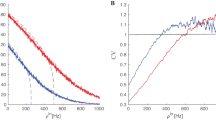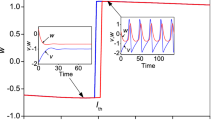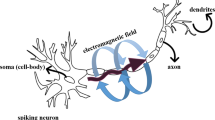Abstract
A significant degree of heterogeneity in synaptic conductance is present in neuron to neuron connections. We study the dynamics of weakly coupled pairs of neurons with heterogeneities in synaptic conductance using Wang–Buzsaki and Hodgkin–Huxley model neurons which have Types I and II excitability, respectively. This type of heterogeneity breaks a symmetry in the bifurcation diagrams of equilibrium phase difference versus the synaptic rate constant when compared to the identical case. For weakly coupled neurons coupled with identical values of synaptic conductance a phase locked solution exists for all values of the synaptic rate constant, α. In particular, in-phase and anti-phase solutions are guaranteed to exist for all α. Heterogeneity in synaptic conductance results in regions where no phase locked solution exists and the general loss of the ubiquitous in-phase and anti-phase solutions of the identically coupled case. We explain these results through examination of interaction functions using the weak coupling approximation and an in-depth analysis of the underlying multiple cusp bifurcation structure of the systems of coupled neurons.














Similar content being viewed by others
References
Bose, A., Kopell, N., & Terman, D. (2000). Almost-synchronous solutions for mutually coupled excitatory neurons. Physica D, 140, 69–94.
Bou-Flores, C., & Berger, A. J. (2001). Gap junctions and inhibitory synapses modulate inspiratory motoneuron synchronization. Journal of Neurophysiology, 85, 1543–1551.
Crawford, J. D. (1991). Introduction to bifurcation theory. Reviews of Modern Physics, 63(4), 991–1037.
Ermentrout, G. B. (2002). Simulating, analyzing, and animating dynamical systems: A guide to XPPAUT for researchers and students. SIAM.
Ermentrout, G. B., & Kopell, N. (1990). Oscillator death in systems of coupled neural oscillators. SIAM Journal on Applied Mathematics, 50(1), 125–146.
Hansel, D., & Mato, G. (1993). Patterns of synchrony in a heterogeneous Hodgkin–Huxley neural network with weak coupling. Physica A, 200, 662–669.
Hansel, D., Mato, G., & Meunier, C. (1993). Phase dynamics for weakly coupled Hodgkin–Huxley neurons. Europhysics Letters, 23, 367–372.
Hansel, D., Mato, G., & Meunier, C. (1995). Synchrony in excitatory neural networks. Neural Computation, 7(2), 307–337.
Izhikevich, E. (1998). Multiple cusp bifurcations. Neural Networks, 11, 495–508.
Izhikevich, E. (2007). Dynamical systems in neuroscience. MIT Press.
Izhikevich, E., & Hoppensteadt, F. (1997). Weakly connected neural networks. New York: Springer.
Kuramoto, Y. (1984). Checmical oscillations, waves and turbulence. New York: Springer.
Li, Y., Wang, Y., & Miura, R. (2003). Clustering in small networks of excitatory neurons with heterogeneous coupling strengths. Journal of Computational Neuroscience, 14(2), 139–159.
Mellen, N., Janczewski, W., Bocchiaro, C., & Feldman, J. L. (2003). Opiod induced quantal slowing reveals dual networks for repiratory rhythm generation. Neuron, 37, 821–826.
Prescott, S., Koninck, Y., & Sejnowski, T. (2008). Biophysical basis for three distinct mechanisms for action potential initiation. PLoS Biology, 4(10), e1000198.
Preyer, A., & Butera, R. J. (2005). Neuronal oscillators in Aplysia californica that demonstrate weak coupling in vitro. Physical Review Letters, 95, 138103.
Purvis, L. K., Smith, J. C., Koizumi, H., & Butera, R. J. (2007). Bursters increase the robustness of rhythm generation in an excitatory network. Journal of Neurophysiology, 97, 1515–1526.
Rinzel, J., & Ermentrout, G. B. (1989). Methods in neuronal modeling (pp. 135–169). MIT Press.
Sieling, F., Canavier, C., & Prinz, A. (2009). Predictions of phase-locking in excitatory hybrid networks: Excitation does not promote phase-locking in pattern-generating networks as reliably as inhibition. Journal of Neurophysiology, 102, 69–84.
Smith, J. C., Ellenberger, H. H., Ballanyi, K., Richter, D. W., & Feldman, J. L. (1991). Pre-Bötzinger complex: A brainstem region that may generate respiratory rhythm in mammals. Science, 254, 726–729.
Song, S., Sjöström, P. J., Reigl, M., Nelson, S., & Chklovskii, D. (2005). Highly nonrandom features of synaptic connectivity in local cortical circuits. PLoS Biology, 3(3), e68.
Terman, D., Kopell, N., & Bose, A. (1998). Dynamics of two mutually coupled slow inhibitory neurons. Physica D, 117, 241–275.
Van Vreeswijk, C., Abbott, L., & Ermentrout, G. B. (1994). When inhibition not excitation synchronizes neural firing. Journal of Computational Neuroscience, 1, 313–321.
White, J., Chow, C., Ritt, J., Soto-Tervino, C., & Kopell, N. (1998). Synchronization and oscillatory dynamics in heterogeneous, mutually inhibited neurons. Journal of Computational Neuroscience, 5, 5–16.
Acknowledgements
This work was supported by grants from the National Institutes of Health (R01-H088886, PI: Butera; and R01-NS054281, PI: Canavier, subcontract to R. Butera).
Author information
Authors and Affiliations
Corresponding author
Additional information
Action Editor: David Terman
Appendices
Appendix A: Hodgkin–Huxley model
The equations for the Hodgkin–Huxley Model are:
With \(g_{\rm Na}=120\:\frac{\rm mS}{{\rm cm}^2}\), \(g_K=36\:\frac{\rm mS}{{\rm cm}^2}\), \(g_L=0.3\:\frac{\rm mS}{{\rm cm}^2}\), \(E_{\rm Na}=50\:{\rm mV}\), \(E_K=-77\:{\rm mV}\), \(V_L=-54.6\:{\rm mV}\), \(C_m=1\:\frac{\mu \rm F}{{\rm cm}^2}\), \(I_{\rm stim}=10\:\frac{\mu \rm A}{{\rm cm}^2}\).
Appendix B: Wang–Buzsaki model
The equations for the Wang–Buzsaki Model are:
With \(g_{\rm Na}=35\:\frac{\rm mS}{{\rm cm}^2}\), \(g_K=9\:\frac{\rm mS}{{\rm cm}^2}\), \(g_L=0.1\:\frac{\rm mS}{{\rm cm}^2}\), \(E_{\rm Na}=55\:{\rm mV}\), \(E_K=-90\:{\rm mV}\), \(V_L=-65\:{\rm mV}\), \(C_m=1\:\frac{\mu \rm F}{{\rm cm}^2}\), \(I_{\rm stim}=10\:\frac{\mu \rm A}{{\rm cm}^2}\), φ = 5.
Rights and permissions
About this article
Cite this article
Bradley, P.J., Wiesenfeld, K. & Butera, R.J. Effects of heterogeneity in synaptic conductance between weakly coupled identical neurons. J Comput Neurosci 30, 455–469 (2011). https://doi.org/10.1007/s10827-010-0270-3
Received:
Revised:
Accepted:
Published:
Issue Date:
DOI: https://doi.org/10.1007/s10827-010-0270-3




